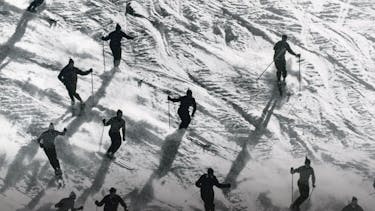The year 1959 brings a dramatic change for the Fischer ski factory. Company founder Josef Fischer senior passes away in February. His children Josef Fischer junior and Selma Sturmberger take over the running of the company. The new man in charge, not yet 30 years of age, starts to implement new ideas and visions under his leadership at the company. In doing so, Josef Fischer thinks not only in terms of new materials and technologies but also gives the marketing of the Fischer ski factory a whole new, modern approach.
In 1955 Josef Fischer junior takes on Ernest Simharl, who is not only his first recruit, but soon becomes his most trusted member of staff. Born in Ried, Simharl has a reputation among his friends and sports colleagues (one of whom is Josef Fischer) as a ski insider.
In turn, Ernest Simharl enlists the services – also in 1955 – of designer Rudolf Ferch from Linz Art College. Ferch's first job is to design new letter paper for the company.
Besides Josef Fischer it is Ernest Simharl and Rudolf Ferch who play a crucial role in shaping the Fischer company. In 1957, Fischer, in the persons of Josef Fischer and Ernest Simharl, is represented for the first time with its own stand at the German trade fair for sporting goods in Wiesbaden. They present the latest models against the will of Josef Fischer senior as the travel and fair expenses are a thorn in his side. It is not until the last day of the fair that an order placed by German wholesaler Oskar Schmitz saves the two of them from the wrath of Josef senior. Fischer and Simharl pursue this new marketing approach relentlessly. By 1957 the company has already managed to increase its export share considerably. In 1960, exports outnumber sales in Austria for the first time ever.
The visual presence in the outside world also undergoes a dramatic change. In 1958 Rudolf Ferch designs the new company logo: the Fischer triangle. It becomes one of the best-known Austrian trademarks and is recognised worldwide.

Shortly after the death of his father, Josef Fischer starts to plan the new ski factory in Ried-Angerwaschen which soon becomes the biggest ski factory in the world. Josef Fischer's keen interest in Alpine racing plays a key role in this rapid rise. The first major international successes ensure that as a ski manufacturer, Fischer soon enjoys an excellent reputation beyond the borders of Austria.
Above all, however, it is the new ideas that Josef Fischer introduces to ski production which not only help Fischer skis gain wide acceptance but also make them unique and highly coveted. In 1957, after persevering with the multilayer glued ski and overcoming his father's strong resistance to it, Josef Fischer starts to develop the metal ski. He draws his inspiration from the metal ski made by the American Howard Head. Josef Fischer wants to be the first in Europe to produce a metal ski and starts experimenting with aluminium. He receives support for this from the development manager at the Vereinigte Metallwerke in Ranshofen, not far from Ried and near Braunau. "I simply didn't stop until I reached the point where I found a practicable design. The biggest difficulty was joining the aluminium to steel or wood," remembers Josef Fischer. He succeeds in 1960. Fischer manages to combine the various components in one outstanding ski. The metal ski is on the market for the first time. It is the legendary "Alu Steel", with which Egon Zimmermann wins Olympic gold in 1964.
New ideas and innovations in ski production, marketing, public relations and export. Participation in racing and the building of a new ski factory. Josef Fischer sets a whole new course for the company. And enables Fischer to rise under his leadership to become the biggest and most innovative ski factory in the world as a result.


